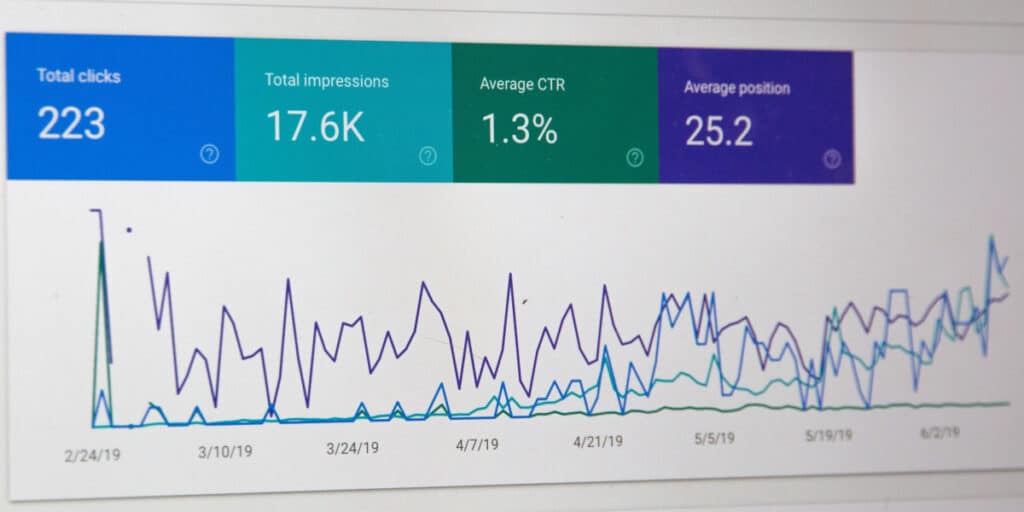10 Key Analytics Metrics to Track (& Why!)
Posted on:

If you have a business website but aren’t collecting any data, you’re just washing money and time down the drain. Digital tools for analytics have made it exponentially easier for businesses to track how their marketing efforts are performing, and whether they’re worth the money put into them. Unfortunately many business owners aren’t effectively using the data they have access to. This is a huge mistake!
With so many potential data points to track and compare, it can be difficult to figure out what’s worthwhile and what you can ignore. We’ll walk you through some of the important metrics to keep an eye on, and why you should care about them:
Why It’s Important to Collect Analytics Data
Your business’ website is one of the most important tools you have to grow your client base and revenue. It also can be one of the biggest expenditures in your business, especially if you’re not keeping track of how you’re spending your money and whether you’re getting the most out of your efforts.
Unlike traditional outbound marketing tactics, such as direct mail, TV ads, and billboards, it is incredibly easy to collect and compare the success of your online campaigns. Platforms such as Google Analytics (provided you have the code installed on your website and you’ve signed up for an account), collects and tracks a massive amount of data automatically.
This data allows you to see a lot about your website, including:
- How many people visit your website
- Where they come from (direct traffic, search engines, social media, etc.)
- Whether they’re new or returning users
- What type of device they’re using
- What keywords they searched to find your website
- What pages they visited
- How long they stayed on your website or any given page
- Where they’re located
You can use this data to check that your website is functioning properly, that your users are finding value in your website, and that you’re getting not just visitors, but buyers.
Not making use of the analytics data on your website, you’re just wasting the time and money you put into your website, and you aren’t going to grow your business as quickly.
10 Key Analytics Metrics to Track

Now that you understand the importance of tracking data in Google Analytics or through another source, let’s dig into the 10 most important metrics you need to track, and why:
Users
This is a given. You want to know how many people are visiting your website during a given period of time.
Beyond the number, users are further broken down into two categories: New and Returning. New visitors are those who have not visited your site before, while returning visitors are those who have. Knowing the proportion of new vs. returning visitors is important to understanding how your web presence is growing. If you have far more returning visitors than new visitors, it may be time to step up your SEO or advertising game to bring in new visitors.
Google Analytics uses cookies to track user data, even though it’s not completely accurate. For example, if a user uses separate devices or browsers to visit a site (desktop computer then mobile device, or Chrome and then Firefox), deletes or blocks cookies, or uses Incognito or Private browsing, that user is then counted as separate new users for those different encounters.
Sessions

Sessions are defined as groups of user interactions that take place in a given time frame.
A session begins when a user lands on your website and ends after 30 minutes of activity, at midnight, or if the user enters your site one way, leaves, and comes back through another campaign (ex: User enters by clicking on a social media post, leaves, and then searches you in Google and clicks on your website again)
Sessions are different from users in tracking data, as one user can trigger multiple sessions.
It’s important to monitor your session counts, including the source of those sessions, to determine how successful your various online marketing campaigns are performing. If email marketing brings you the highest number of new sessions, you know that your users find your emails interesting and you may want to consider shifting more of your focus to email.
Pages Per Session

The number of pages a user views in a session is called pages per session.
If you see your pages per session number increasing, it could mean that users are finding your website more informative and engaging. However, don’t rely solely on pages per session to determine your success; sometimes users can find the information they want very quickly, meaning they only visit one page but their visit resulted in a sale for you.
To encourage an increase in your site’s pages per session number, it’s important to craft a content strategy that creates pathways from one page to another through your website. You do this with internal linking, putting links to other pages on your site in relevant areas on any given page.
Devices
This metric tracks how many people visit your website on different devices: Desktop, mobile, and tablet devices.
While it’s important that your website is properly optimized for both mobile and desktop browsing, if you see that more people browse from one type of device it may help you make important decisions on where to focus your efforts.
Source/Medium & Channels
Knowing how people get to your website is important for understanding whether your efforts are paying off.
Source traffic shows you where traffic comes from, such as search engines or directly typing your URL into their browser. The medium metric gives you a general category of how the user arrives on your website, such as organic, paid, or social.
Channels tells you groups of traffic sources within the same medium, such as organic search, direct, social, and email.
Pageviews & Unique Pageviews

The total number of views an individual page on your website has is called pageviews. This is a total of all the visitors who have been to an individual page, and it counts repeat users as individual pageviews each time.
So, if someone visits the same page on your website three times, that counts as three separate pageviews.
Unique pageviews, on the other hand, measure how many times a page is viewed in an individual session. If a person goes to the same page twice during the same visit to your website, for example, the unique pageviews metric would only track that visit as one.
Average Time on Page
Google tracks the average amount of time users spend on a single page of your website.
By looking at the average time visitors spend on pages, you can determine how interesting and engaging the content on that page may be. If you’re seeing low time on page on a long blog post, for example, you know there’s something about the content that’s not engaging users.
Adding elements such as videos and infographics can help increase the time spent on page, as these items make the page visually interesting and present the content in an easily digestible manner.
Landing Pages

Looking at the pages users enter your website on is the basis of the landing pages metric. This helps you see whether certain pages are bringing in more users and why, such as the pages being connected to more commonly searched keywords.
Exit Pages
In addition to analyzing what pages users enter your website on, it’s important to also check what pages they exit your website on.
Identifying pages that are common exit pages can give you the opportunity to optimize those pages to better engage users and potentially even push them toward other pages.
Bounce Rate
Google defines a bounce as a user that enters and leaves your website from a single page. This means that users who bounce only interact with one page and do not trigger any additional requests to the Analytics server.
Bounce rate is the percentage of all sessions on your website that bounced.
Don’t get too hung up on bounce rate, though. One page could have a high bounce rate because it gives the user exactly what they want and converts users into buyers, such as a landing page to purchase an online course, while a high bounce rate on a page that’s intended to move visitors to other parts of your site isn’t a good sign.
SEO for Small Businesses
There’s a lot to know and understand when it comes to how your website’s SEO is performing. At 270net Technologies, our team knows the key metrics inside and out, and can help you understand which ones are most important for your website. Whether you’re looking to get your SEO campaign off the ground or you’re looking for someone to take it to the next level, we’ve got the skills and experience you need. Schedule a consultation today!